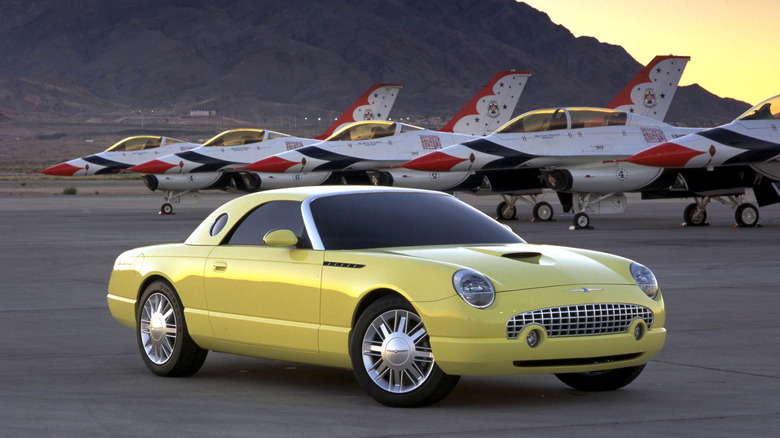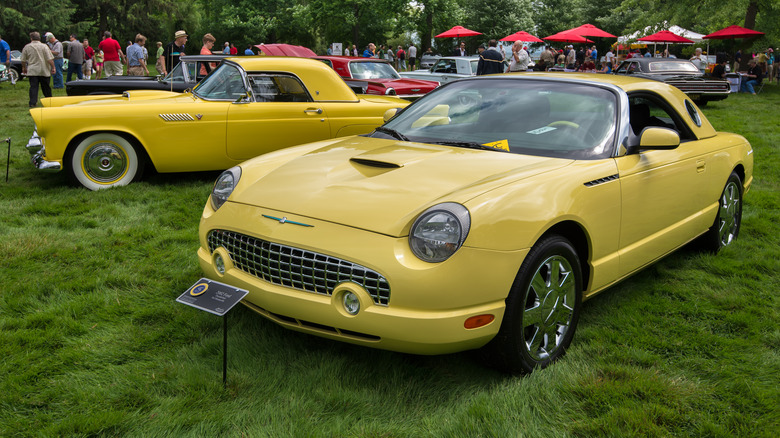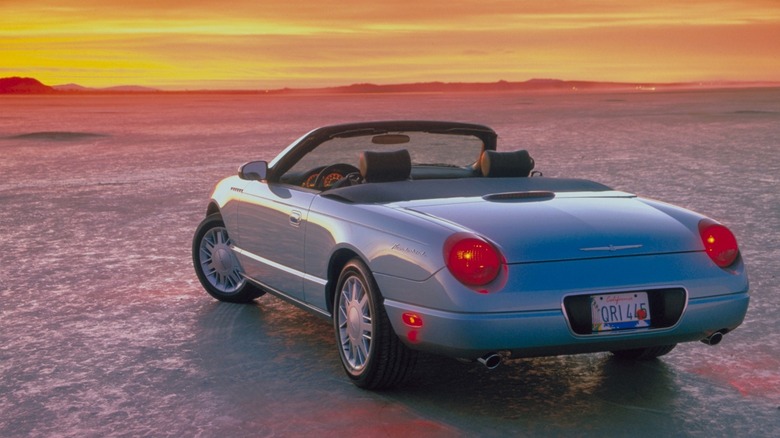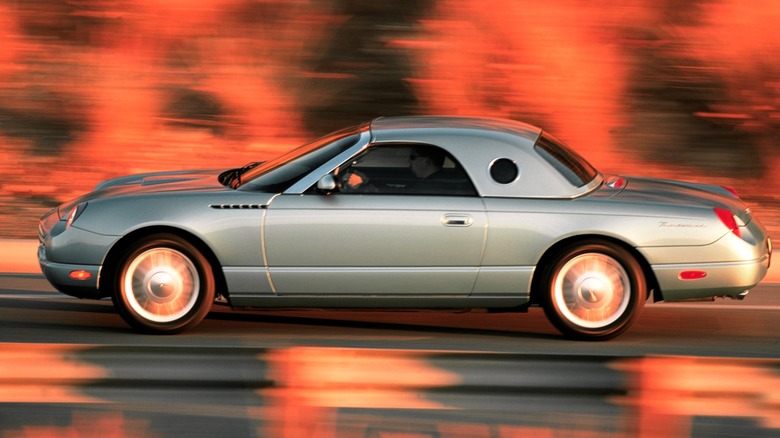The Reason Why Ford Discontinued The Thunderbird
For decades, the Thunderbird was a staple in Ford's lineup. All told, the vehicle lasted 11 generations before ending its run in 2005.
With a history as long as the Thunderbird's, there are bound to be hits and misses among the model years. The Thunderbird of the mid-1950s is a quintessentially American piece of car-design history and is recognized all over the world as an example of good design.
By the time the 1970s started, the Thunderbird design was getting a bit stale. Gone were the fins and miles of chrome. Those works of art were replaced with straight, boxy cars with hoods long enough to land a helicopter. Bad design choices weren't unique to the Thunderbird in the 1970s. It was a dismal time for American cars in general. But the Thunderbird's transformation is arguably the most egregious.
The Thunderbird ended production for the first time in 1997. By that time, the 10th generation Thunderbird looked a lot like a squished two-door Crown Victoria. Hardly exciting, to say the least.
However, at the start of the new millennium, Ford decided to resurrect the Thunderbird nameplate. This Thunderbird would be the final generation.
A slow death
The 11th and final-generation Thunderbird sported a retro-inspired design. Depending on who you talk to, the design was either a fun callback to a classic Ford design or a garish monstrosity. The front grille sported a chrome grimace that looked like the Thunderbirds of the '50s if you were standing really far away.
This is the same era in car design that birthed the PT Cruiser. There was clearly something malevolent going around the car industry at the time.
Mechanically, this era was where the Thunderbird really got strange. It shared a platform with the Jaguar S-Type sedan, and Ford had a few good engines to put in the Thunderbird: The 5.0L from the Mustang, which is a legendary engine, and the 4.6L Modular, which is reliable and competent. But instead, Ford shoved a Jaguar V8 under the hood. The engine wasn't a slouch, producing 280 horsepower, per Edmunds. It wasn't a terrible car, but a sad interior combined with divisive styling meant that the Thunderbird's best days were behind it.
According to Hagerty, sales dropped off in 2003, with under 15,000 Thunderbirds leaving the dealership lot. Its last model year was 2005.
It could be argued that the 11th generation outright killed the Thunderbird. But history tells us that the car's death happened slowly over decades and several generations.
The reason why Ford discontinued the Thunderbird
The Thunderbird was an odd car to say the least and it was quite unlike any other car on the market at the time, much less a Ford.
The bizarre styling of the Thunderbird didn't quite jive with the rest of Ford's lineup at the time. Think of how jarring it would be to walk into a Ford dealership in 2002 and see the Thunderbird sitting next to an exponentially more sedate Explorer or F-150. Compared to the somewhat uninspired Mustang of the era, the Thunderbird looks downright wacky.
The Thunderbird looked less like the 1950s Sunday driver it was trying to invoke and more like a pastel-colored shark wearing braces. Reviews in 2002 actually praised the car's look. Some saw it as a daring design from an automaker that was willing to do something different in an era where that wasn't common.
While not quite as legendarily disastrous as the Pontiac Aztek or aforementioned PT Cruiser, the Thunderbird's retro-futuristic design leaves a lot to be desired after about 20 years of hindsight.
A retro Sunday driver
When it came to driving characteristics, the Thunderbird couldn't quite figure out what it was. On one hand, it was meant to be a continuation of luxury coupes from 60-70 years ago; on the other, it was built on a platform intended for sport sedans.
Reviewers were flummoxed. The Jaguar-sourced V8 gave the T-bird plenty of power, but it was hampered by its incredible weight of over 3,800 pounds. That's over 500 pounds more than the fifth-generation Corvette of the early 2000s. The result was confusing to drive, though it's worth noting most publications at the time enjoyed the experience, praising the smooth power delivery and comfortable ride.
Today, 11th-generation Thunderbirds fetch between the $20,000 and $30,000 mark at auction. One-owner models with low miles can reach upwards of $35,000 on auction sites like Bring a Trailer. That puts the value on par with Thunderbirds from the 1950s.
Despite looking more like a fish than a Thunderbird, there hasn't been another car like the last Thunderbird since it departed Ford dealerships years ago. In 2022, with automakers' sights locked on SUV-heavy future, there might not be anything like it for a while.



